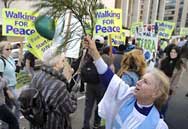
Sally Bingham: “God is green”
Last year, Prestonwood Baptist Church, a conservative megachurch in Plano, Texas, had a monthly utility bill of $250,000. It caters to a Sunday congregation of 26,000, in four buildings and a million square feet of space. “The Bible says, ‘Let nothing be wasted’,” argues Mike Buster, Prestonwood’s executive pastor. “The Bible
commands us to be good stewards of all of our resources. To be able to save money and use it for ministry and missions.” Seven months into an energy reduction program the church has saved half a million bucks, reports Newsweek.
In San Francisco, an outfit called Interfaith Power & Light, started by an Episcopal priest named Sally Bingham, has 4,000 churches, synagogues, mosques and even a group of Jains (people who follow an ancient Indian religion) on its roster. Its state chapters teach congregations how to conserve energy, skills it hopes they’ll also apply at home. The Quakers who, not surprisingly, have been at the forefront of the green-church movement, are seeing a surge of interest in the intersection between faith and ecology. Ruah Swennerfelt runs Quaker Earthcare Witness, a nonprofit in Vermont. In November, she and her husband, both in their 60s, will walk the 1,400 miles between Vancouver and San Diego–“it’s a pilgrimage of sorts,” she says
Swennerfelt practices what she preaches. She works out of her home, which is off the grid: in her case, the lights are off, even when somebody is at home.
As factions in the evangelical world duke it out over whether environmentalism should be a theological priority, a growing number of churches, synagogues and mosques nationwide are undertaking serious efforts to make their buildings “green.”